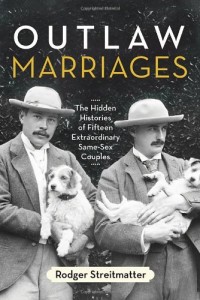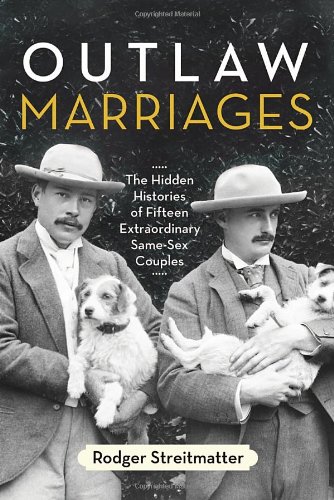 Outlaw Marriages: The Hidden Histories of Fifteen Extraordinary Same-Sex Couples
Outlaw Marriages: The Hidden Histories of Fifteen Extraordinary Same-Sex Couples
by Rodger Streitmatter
Beacon Press. 224 pages, $26.95
CLICHÉS about who stands behind every “great man” aside, Rodger Streitmatter is convinced that behind many prominent gay and lesbian artists and writers was a same-sex partner who’s often given less credit than he or she deserves. In Outlaw Marriages, Streitmatter, a journalist and cultural historian at American University, asks us to enter the world of fifteen prominent Americans through the portal of their long-term same-sex relationships.
Having written extensively on the intersection of media and GLBT issues and authored seven books, Streitmatter explores the “hidden histories” of these extraordinary same-sex couples starting in the mid-19th century with Walt Whitman and his partner Peter Doyle and continuing on to Audre Lorde and Frances Clayton. In most of the couples (seven of which are women) only one of the partners is well-known today—Jane Addams, Greta Garbo, Aaron Copland, and James Baldwin (their partners being, respectively, Mary Rozet Smith, Mercedes de Acosta, Victor Kraft, and Lucien Happersberger)—while in others, such as Robert Rauschenberg and Jasper Johns or Gertrude Stein and Alice B. Toklas, both members are famous in their own right.
In a ten-page profile of Tennessee Williams and Frank Merlo, Streitmatter stresses the decisive role that Merlo played in Williams’ life. When Merlo accompanied the playwright to a business meeting, he was asked, “And what do you do, young man?” he replied, “My job is to sleep with Mr. Williams.” But Merlo did much more than that. He “single-handedly stabilized Tennessee Williams’ life and career,” according to Streitmatter. The relationship began in 1948 in the aftermath of A Streetcar Named Desire, at a time when Williams was depressed and aimless in his career. Merlo, who never had much of a career of his own, promptly assumed control and kept Williams focused and productive until Merlo’s death in 1963.
Or consider Whitman and Peter Doyle, the duo that opens the book. Streitmatter’s focus is not on Whitman’s gayness but on the importance of the relationship itself, which happened to involve two men. To be sure, just being in a relationship helped Whitman to articulate his gayness in his work. Doyle also provided a source of material for the poet. As luck would have it, Doyle was in the Ford’s Theater on the evening when Lincoln was assassinated. By sharing this experience with Whitman, he may have been instrumental in the writing of “O Captain! My Captain!”
Gertrude Stein was a catalyst for scores of artists and writers, but when it came to her own writing she was often quite hapless, blocked, and failing. It was Alice B. Toklas who encouraged Stein to keep to the grindstone, guiding her to critical and financial success. For all the book’s ironic title, Toklas really was indispensable in the writing of Stein’s Autobiography of Alice B. Toklas.
Streitmatter’s style is factual and non-speculative, carefully observing a professional distance from his subjects. He lets us know that the couples have consummated their relationship, but he usually keeps out of the bedroom. The most explicit sexual terminology is employed in describing the homoerotic art collection of Ned Warren who, together with his life and business partner John Marshall, transformed the classical antiques collections of New York’s Metropolitan Museum of Art and Boston’s Museum of Fine Arts at the turn of the 20th century.
Streitmatter often gets at his subjects through quotations that appeared in contemporary newspapers. While this device can sometimes get cumbersome, it works well with his use of obituaries to end the discussion of each figure. In this way we can interpolate the shifts in public opinion on the topic of homosexuality. Based on the sample, homosexuality was simply never mentioned—or was actively covered up—until the mid-20th century. Then, in the 1970’s, we find an increasing use of institutionalizing conventions to convey the meaning (“longtime companions” in The New York Times’ formulation starting in the 80’s).
Streitmatter relies mostly on biographies and other scholarly literature, as well as newspaper archives, and he provides a detailed list of references. In Outlaw Marriages he distills a wealth of information down to a lively and effective series of double portraits.
________________________________________________________
Yoav Sivan, an Israeli journalist, is a visiting scholar in the Department of Sociology at NYU. He maintains a website at www.YoavSivan.com.






